外研版(三年级起点) 五年级下册 Review Module unit 2 课件(25张PPT)
文档属性
| 名称 | 外研版(三年级起点) 五年级下册 Review Module unit 2 课件(25张PPT) | 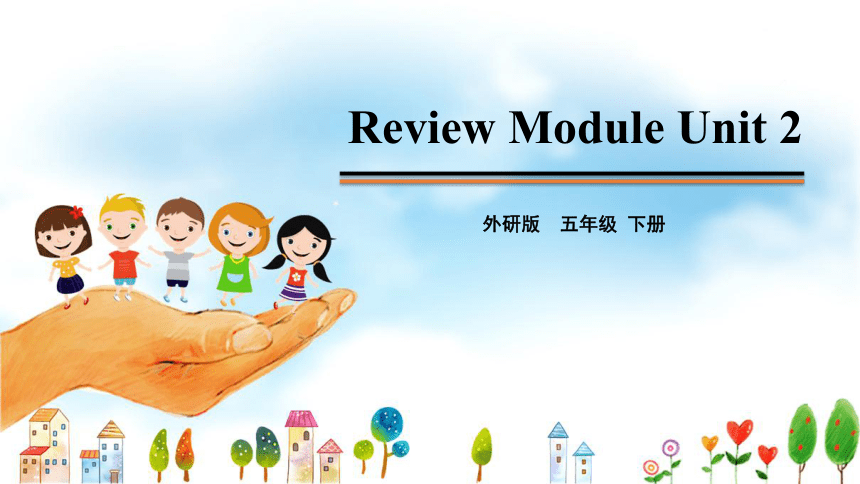 | |
| 格式 | pptx | ||
| 文件大小 | 2.2MB | ||
| 资源类型 | 教案 | ||
| 版本资源 | 外研版(三年级起点) | ||
| 科目 | 英语 | ||
| 更新时间 | 2021-03-29 23:16:44 | ||
图片预览

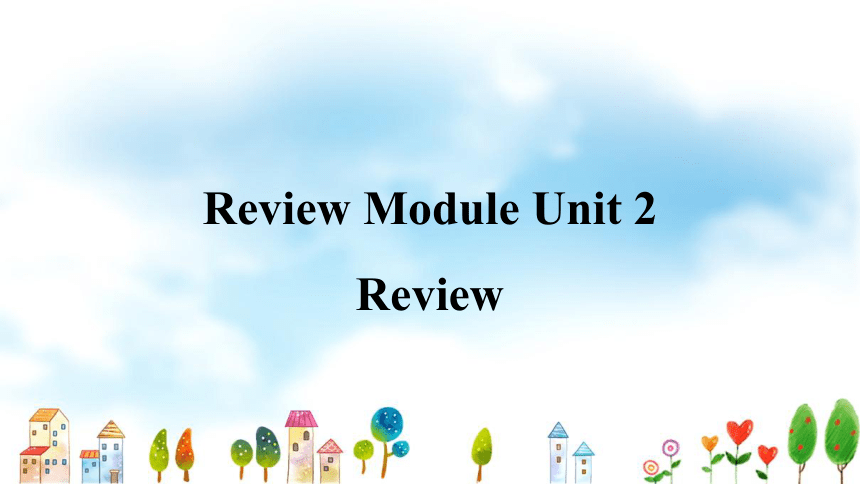

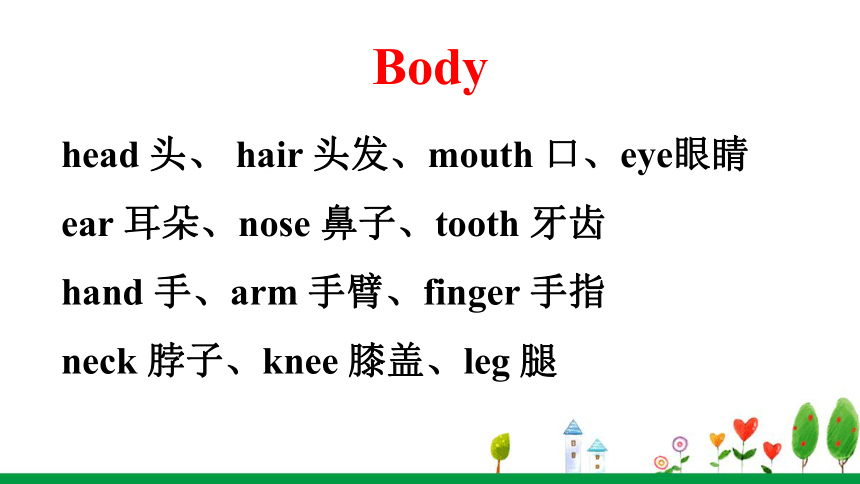
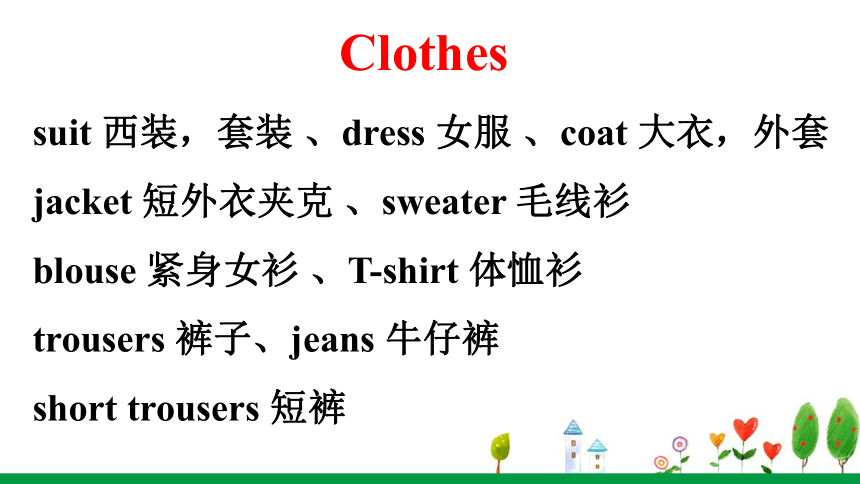
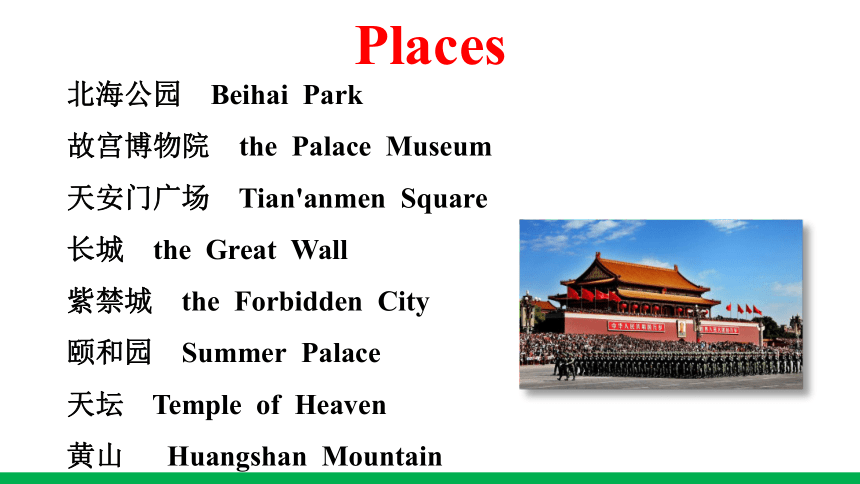
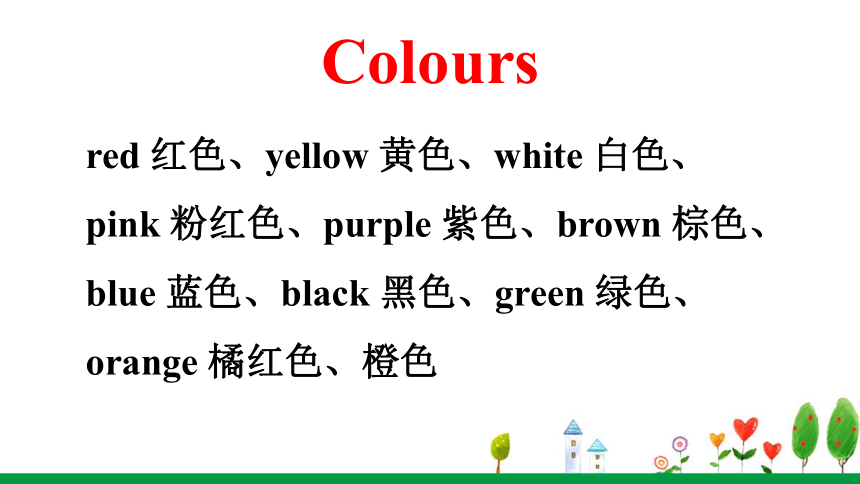
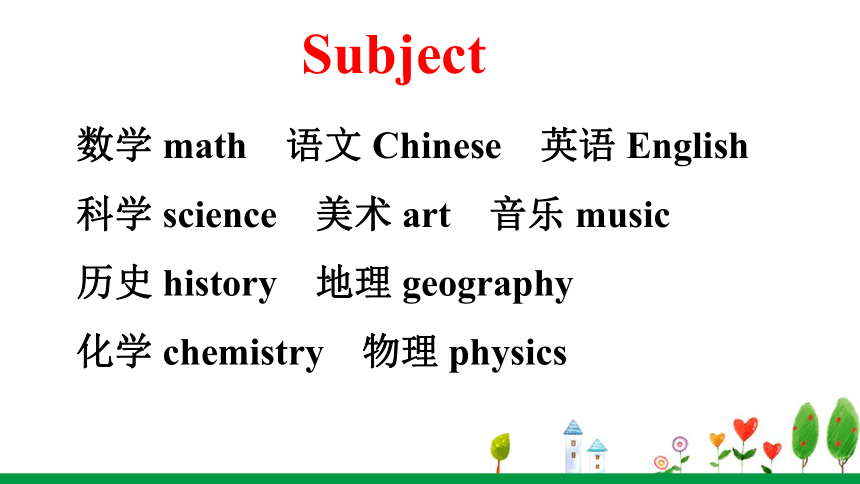
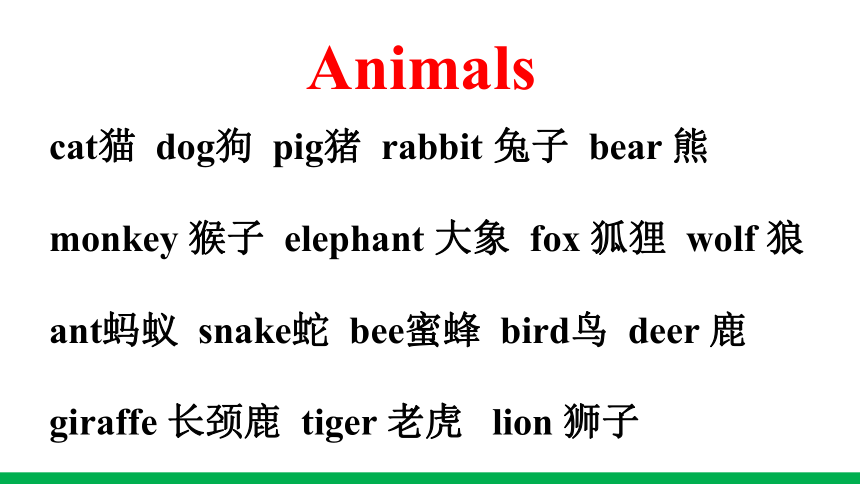
文档简介
Review Module Unit 2
外研版 五年级 下册
Review Module Unit 2
Review
Jobs
fireman消防员、doctor医生、 nurse护士、 cook厨师、driver司机、singer歌手、
dancer 舞蹈演员、teacher 老师、driver司机 、
waiter男服务员、waitress女服务员、worker 工人、
policeman男警察、 policewoman女警察、 carpenter木匠 、cashier 收银员
Body
head 头、?hair 头发、mouth 口、eye眼睛
ear 耳朵、nose 鼻子、tooth 牙齿
hand 手、arm 手臂、finger 手指
neck 脖子、knee 膝盖、leg 腿
Clothes
suit 西装,套装?、dress 女服?、coat 大衣,外套?
jacket 短外衣夹克?、sweater 毛线衫
blouse 紧身女衫?、T-shirt 体恤衫?
trousers 裤子、jeans 牛仔裤?
short trousers 短裤?
Places
北海公园 Beihai?Park?
故宫博物院 the?Palace?Museum?
天安门广场 Tian'anmen?Square?
长城 the?Great?Wall?
紫禁城 the?Forbidden?City
颐和园 Summer?Palace?
天坛 Temple?of?Heaven?
黄山? Huangshan?Mountain?
Colours
red 红色、yellow 黄色、white 白色、
pink 粉红色、purple 紫色、brown 棕色、blue 蓝色、black 黑色、green 绿色、
orange 橘红色、橙色
Subject
数学 math 语文 Chinese 英语 English 科学 science 美术 art 音乐 music
历史 history 地理 geography
化学 chemistry 物理 physics
Animals
cat猫 dog狗 pig猪 rabbit 兔子 bear 熊
monkey 猴子 elephant 大象 fox 狐狸 wolf 狼
ant蚂蚁 snake蛇 bee蜜蜂 bird鸟 deer 鹿
giraffe 长颈鹿 tiger 老虎 lion 狮子
Review Module Unit 2
Presentation
在一般过去时态的句子中常有表示过去的时间状语,如yesterday,last Sunday,last year,the day beforeyesterday 等。
一般过去时
句型结构:
主语+动词过去式+其他.
否定句:“主语+didn’t+动词原形+其他.”
didn’t是 didnot 的缩写形式。
1.一般直接在词尾加ed。例如:play—played
动词过去式的变化规则:
2.以不发音的字母e结尾的动词在词尾直接加d。例如:live—lived
3.末尾只有一个元音字母和一个辅音字母的重读闭音节,应双写末尾的辅音字母,再加-ed例如:stop-stopped
4.以“辅音字母+y”结尾的,变y为i再加-ed 例如:study-studied
future
now
past
一般将来时:表示将来某一时刻或将来某一段时间内
经常发生的动作或状态。常常和表示将来的时间状语连用。
表示将来的时间状语
tomorrow
next day
soon
the day after tomorrow(后天)
week
month,year
1.be going to,跟“动原”,计划、准备或打算;表可能,有必然,通过现象来判断。be的形式要注意,它要随着人称变,否定句,很简单,not加在be后边;疑问句,需牢记,be 应提到主语前。
2.will用于表将来,原形动词紧相连。Not 放在它后边,表示否定事有变。若要变成疑问句,will提到句最前。
一般将来时口诀:
Let's chant
Big, big. It’s too big for you.
Small, small. It’s too small for him.
Easy, easy. It’s too easy for me.
Hard, hard. It’s too hard for her.
A:Hello.XXX.
B:Hello.XXX,look at this blue/red… T-shirt/hat/dress/bag/coat….
A:It’s too big/small/heavy… for you.Try this one.
B:It’s nice. Thank you.
A:You’re welcome.Bye-bye,XXX.
B:Bye-bye.
用英语提建议的八个句型:
A、用Shall we...?在表示建议或征求对方意见时,可用以Shall开头的一般疑问句。其肯定回答一般可用:All right, OK, Good idea等。
B 、用Let's...?表示“让我们”(包括双方在内)做某事“这一建议时要用以Let's 开头的祈使句。而Let us在表示让我们做某事时,不包括对方在内。如:Let's go and see the pandas. Let us go, will you?让我们去吧,好吗?
C、用Why not...?Why not...?意思是:为什么不......?后接不带to的不定式(即动词原形)。Why not...?是省略了主语的省略形式,完整句Why don't you/they/we...?如:Why don't you go with me? Why don't you try again?=Why not try again?
D、用What about...?意为“......怎么”后可接名词、代词和动名词。如:What about going out for a walk? I'm going to the park.What about you?
E 、用had better 意为“最好”,“还是......好”,常用于口语,后接动词原形。如:You had better stay at home. You'd better go now.
F、 用Don't...来表示建议,通常用于祈使句的否定形式中。如:Don't play in the street. Don't throw it like that.
G、Would you like+短语?这个句型意思是“......怎么样?”后接sth. 或to do sth.如:Would you like another cup of tea? Would you like some colour pencils?
H、Will you please+动词原形...?它的意思是“请你......好吗?”如:Will you please come tomorrow? Will you please pick it up?
Thank you!
外研版 五年级 下册
Review Module Unit 2
Review
Jobs
fireman消防员、doctor医生、 nurse护士、 cook厨师、driver司机、singer歌手、
dancer 舞蹈演员、teacher 老师、driver司机 、
waiter男服务员、waitress女服务员、worker 工人、
policeman男警察、 policewoman女警察、 carpenter木匠 、cashier 收银员
Body
head 头、?hair 头发、mouth 口、eye眼睛
ear 耳朵、nose 鼻子、tooth 牙齿
hand 手、arm 手臂、finger 手指
neck 脖子、knee 膝盖、leg 腿
Clothes
suit 西装,套装?、dress 女服?、coat 大衣,外套?
jacket 短外衣夹克?、sweater 毛线衫
blouse 紧身女衫?、T-shirt 体恤衫?
trousers 裤子、jeans 牛仔裤?
short trousers 短裤?
Places
北海公园 Beihai?Park?
故宫博物院 the?Palace?Museum?
天安门广场 Tian'anmen?Square?
长城 the?Great?Wall?
紫禁城 the?Forbidden?City
颐和园 Summer?Palace?
天坛 Temple?of?Heaven?
黄山? Huangshan?Mountain?
Colours
red 红色、yellow 黄色、white 白色、
pink 粉红色、purple 紫色、brown 棕色、blue 蓝色、black 黑色、green 绿色、
orange 橘红色、橙色
Subject
数学 math 语文 Chinese 英语 English 科学 science 美术 art 音乐 music
历史 history 地理 geography
化学 chemistry 物理 physics
Animals
cat猫 dog狗 pig猪 rabbit 兔子 bear 熊
monkey 猴子 elephant 大象 fox 狐狸 wolf 狼
ant蚂蚁 snake蛇 bee蜜蜂 bird鸟 deer 鹿
giraffe 长颈鹿 tiger 老虎 lion 狮子
Review Module Unit 2
Presentation
在一般过去时态的句子中常有表示过去的时间状语,如yesterday,last Sunday,last year,the day beforeyesterday 等。
一般过去时
句型结构:
主语+动词过去式+其他.
否定句:“主语+didn’t+动词原形+其他.”
didn’t是 didnot 的缩写形式。
1.一般直接在词尾加ed。例如:play—played
动词过去式的变化规则:
2.以不发音的字母e结尾的动词在词尾直接加d。例如:live—lived
3.末尾只有一个元音字母和一个辅音字母的重读闭音节,应双写末尾的辅音字母,再加-ed例如:stop-stopped
4.以“辅音字母+y”结尾的,变y为i再加-ed 例如:study-studied
future
now
past
一般将来时:表示将来某一时刻或将来某一段时间内
经常发生的动作或状态。常常和表示将来的时间状语连用。
表示将来的时间状语
tomorrow
next day
soon
the day after tomorrow(后天)
week
month,year
1.be going to,跟“动原”,计划、准备或打算;表可能,有必然,通过现象来判断。be的形式要注意,它要随着人称变,否定句,很简单,not加在be后边;疑问句,需牢记,be 应提到主语前。
2.will用于表将来,原形动词紧相连。Not 放在它后边,表示否定事有变。若要变成疑问句,will提到句最前。
一般将来时口诀:
Let's chant
Big, big. It’s too big for you.
Small, small. It’s too small for him.
Easy, easy. It’s too easy for me.
Hard, hard. It’s too hard for her.
A:Hello.XXX.
B:Hello.XXX,look at this blue/red… T-shirt/hat/dress/bag/coat….
A:It’s too big/small/heavy… for you.Try this one.
B:It’s nice. Thank you.
A:You’re welcome.Bye-bye,XXX.
B:Bye-bye.
用英语提建议的八个句型:
A、用Shall we...?在表示建议或征求对方意见时,可用以Shall开头的一般疑问句。其肯定回答一般可用:All right, OK, Good idea等。
B 、用Let's...?表示“让我们”(包括双方在内)做某事“这一建议时要用以Let's 开头的祈使句。而Let us在表示让我们做某事时,不包括对方在内。如:Let's go and see the pandas. Let us go, will you?让我们去吧,好吗?
C、用Why not...?Why not...?意思是:为什么不......?后接不带to的不定式(即动词原形)。Why not...?是省略了主语的省略形式,完整句Why don't you/they/we...?如:Why don't you go with me? Why don't you try again?=Why not try again?
D、用What about...?意为“......怎么”后可接名词、代词和动名词。如:What about going out for a walk? I'm going to the park.What about you?
E 、用had better 意为“最好”,“还是......好”,常用于口语,后接动词原形。如:You had better stay at home. You'd better go now.
F、 用Don't...来表示建议,通常用于祈使句的否定形式中。如:Don't play in the street. Don't throw it like that.
G、Would you like+短语?这个句型意思是“......怎么样?”后接sth. 或to do sth.如:Would you like another cup of tea? Would you like some colour pencils?
H、Will you please+动词原形...?它的意思是“请你......好吗?”如:Will you please come tomorrow? Will you please pick it up?
Thank you!
同课章节目录
- Module 1
- Unit 1 We lived in a small house.
- Unit 2 She didn't have a television.
- Module 2
- Unit 1 She learnt English.
- Unit 2 Mr Li was a teacher.
- Module 3
- Unit 1 She had eggs and sausages.
- Unit 2 Sam ate four hamburgers.
- Module 4
- Unit 1 Let's make a home library.
- Unit 2 We can find information from books and CDs.
- Module 5
- Unit 1 It's big and light.
- Unit 2 It's too big for you.
- Module 6
- Unit 1 I went there last year.
- Unit 2 She visited the Tianchi Lake.
- Module 7
- Unit 1 My father goes to work at eight o'clock eve
- Unit 2 I'll be home at seven o'clock.
- Module 8
- Unit 1 Will you help me?
- Unit 2 I made a kite.
- Module 9
- Unit 1 We laughed a lot.
- Unit 2 Mum bought new T-shirts for you.
- Module 10
- Unit 1 Where are you going to go?
- Unit 2 I'm in New York now.
- Review Module
- Unit 1
- Unit 2
